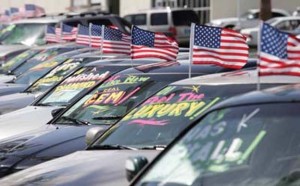“Buy American?” it’s not always easy to figure out what an American car is, these days, considering your Chevy may come from Korea, while your Kia may have been built in West Point, Georgia. But if you’re looking for the communities where shoppers are most likely to purchase one of the Big Three brands, Midwest motorists remain the most loyal to domestic automakers, while those in California and other West Coast communities are overwhelmingly import oriented.
The gap can be significant: in major Midwest markets, Detroit’s Big Three brands routinely capture more than two-thirds of new car sales, while three in four shoppers on the Left Coast turn to either Asian or European marques.
But domestic industry officials insist they’re seeing a shift in momentum, especially as they launch new small, fuel-efficient models that are beginning to gain traction even in import-centric California.
Of 50 metro communities tracked by the online shopping service, CarGurus.com, Detroit and Saint Louis were the most “patriotic,” with buyers turning to domestic brands 67% of the time. Cleveland was close behind, at 59%, followed by Milwaukee, at 58%, and Tulsa, at 57%.
The only one of the Top 10 metro markets that might be considered “coastal” was eighth-ranked Pittsburgh, where domestic models accounted for 54%. In Pennsylvania’s other big urban market, Philadelphia, the figure fell to just 38%.
East Coast markets were decidedly less “loyal” than those in the Midwest, with only 40% of Atlantans opting for U.S. brands, with the figure at 35% in Miami, 33% in Boston and just 32% in New York.
But the real challenge for Detroit’s domestic makers comes from the West Coast, where Japanese imports first got a toe-hold and where foreign brands, in general, overwhelmingly dominate.
At the bottom of the list? Los Angeles, where 39% of buyers favor Asian marques, 34% go for European brands and Detroit’s Big Three pick up the remaining 27%.
San Francisco and San Diego were close behind, with a similar 27% figure for the domestics, but Asian marques garnering even bigger shares than in L.A.
The survey looked at shopping trends over the last six months using CarGurus DealFinder service.
American automakers have beaten a steady retreat to their Midwest base over the past three decades, but domestic officials insist they are pushing hard to improve their presence in the so-called “smile states along the East, West and Gulf Coasts, Ford President of the Americas Mark Field calling that “critical.”
The good news for the Detroit makers is that some of their latest models are gaining traction, particularly in California, which has become one of the fastest-growing markets for the new Ford Fiesta, according to Fields.
General Motors reports similar results for the new Chevrolet Camaro, among other recently-launched offerings.
But the study stresses that Detroit has a long way to go – though the Big Three also have some significant opportunities if they can pick up even a few points of share in coastal communities.
(Which automotive brands actually build the most cars in the U.S.? Click Here to find out.)


I may be a GM/UAW retiree, but in a way I understand why the Midwest remains a bastion of D3 sales and the coastal areas tend to be import-oriented. While some urban areas in the Midwest have been populated by immigrants ( doctors for example) from other countries, we are still pretty rural, very set in our ways, not prone to change. Until recently, the D3 was a very reliable cash cow for the Midwest; if you didn’t work for the auto companies directly, you worked for a supplier or was a businessperson who made a lot of money off of those who were employed by automotive. Certainly the opposite was true on the coasts; a lot of immigrants who brought their own customs and brand-identification (Toyota, Honda) with them, and change was a way of life. It is no wonder the D3 has had trouble gaining inroads into that population. Our (the D3) best hope is that as the second-and third-generation of immigrant families become more assimilated, they will not look at D3 names as “foreign” as their first-generation parents presumably might have. Of course, we better have some darned good products to interest the “coasters” in the first place.
Agreed, and if you see which Detroit products are gaining ground on the Coasts it is clearly the best of the newer models, such as the Ford Fiesta and Chevy Camaro.
Paul E.